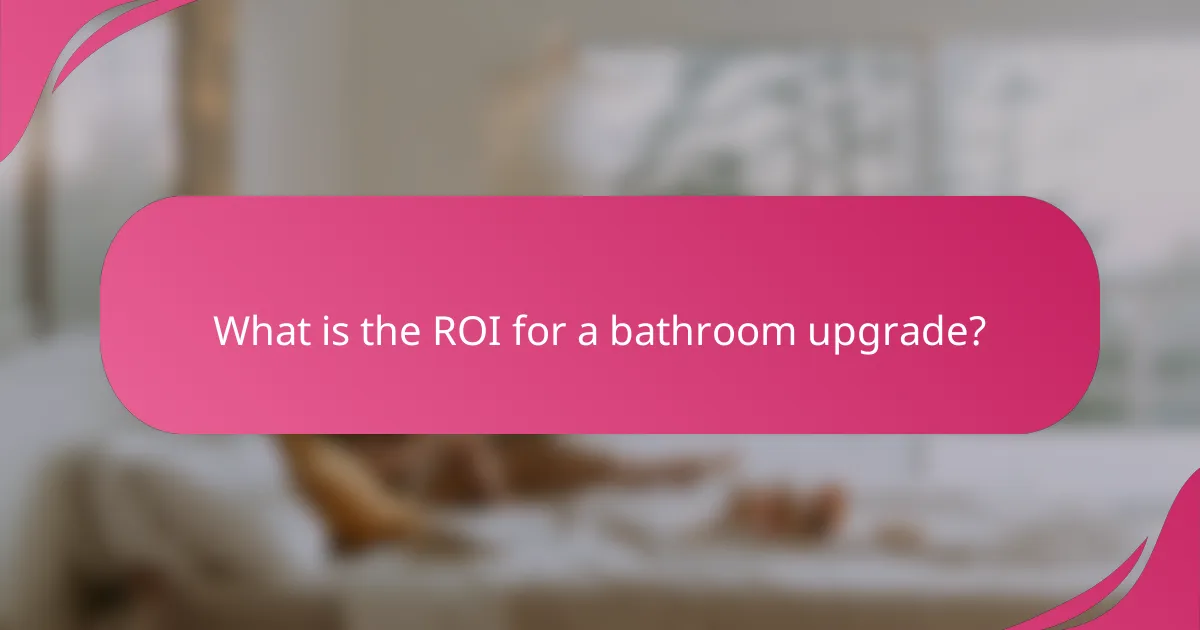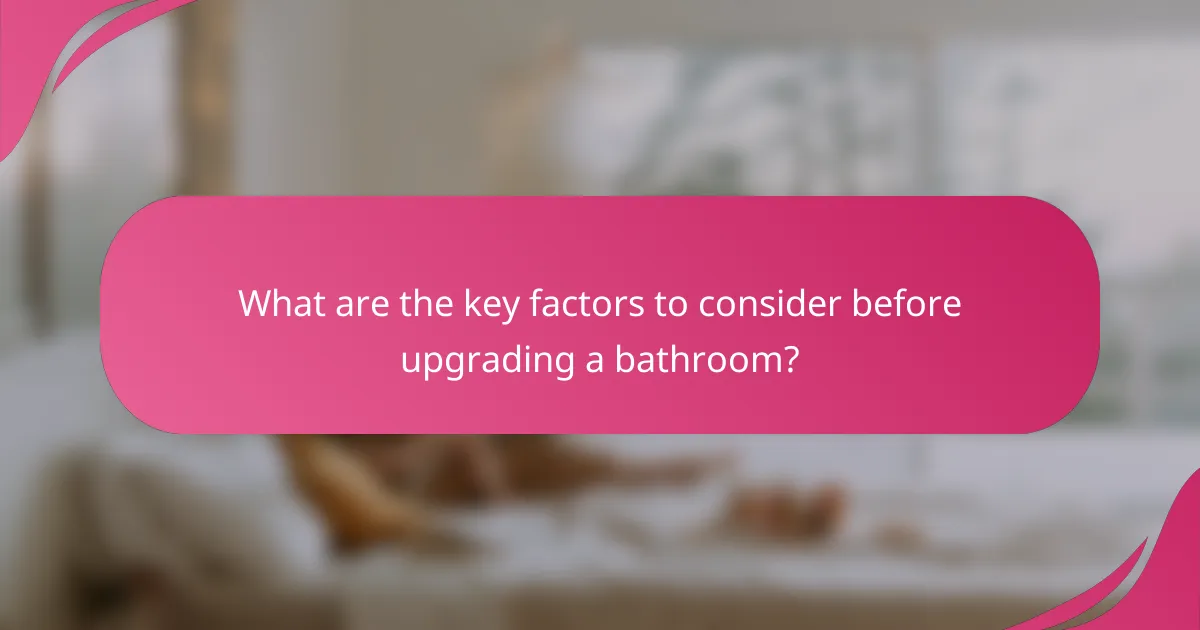Upgrading your bathroom can be a significant investment, with average expenses in Canada ranging from CAD 10,000 to CAD 25,000, influenced by the choice of materials and labor. Homeowners have various financing options available, such as home equity loans and personal loans, to help manage these costs. Additionally, a bathroom renovation can yield a return on investment (ROI) of 60% to 70%, making it a financially sound choice when considering future home value.

What are the average expenses for a bathroom upgrade in Canada?
The average expenses for a bathroom upgrade in Canada typically range from CAD 10,000 to CAD 25,000, depending on the scope and quality of materials used. Homeowners should consider both material and labor costs when budgeting for their renovation project.
Average costs for materials
Material costs for a bathroom upgrade can vary significantly based on the choices made. Basic fixtures and finishes may cost around CAD 1,500 to CAD 3,000, while high-end options can exceed CAD 10,000. Common materials include tiles, vanities, sinks, and faucets, with prices fluctuating based on brand and quality.
For flooring, ceramic tiles may range from CAD 3 to CAD 10 per square foot, while natural stone can go up to CAD 20 per square foot. It’s essential to balance aesthetics with durability and maintenance when selecting materials.
Labor costs in major Canadian cities
Labor costs for bathroom renovations can vary by region, with major cities like Toronto, Vancouver, and Calgary typically having higher rates. On average, labor can account for 30% to 50% of the total renovation budget, with hourly rates for contractors ranging from CAD 50 to CAD 150.
In smaller towns, labor costs may be lower, but it’s crucial to ensure that the contractor is licensed and insured. Always obtain multiple quotes to compare pricing and services offered.
Cost breakdown by project type
The type of bathroom project significantly influences overall costs. A simple cosmetic upgrade, such as painting and replacing fixtures, may cost around CAD 5,000 to CAD 10,000. In contrast, a full remodel that includes structural changes can range from CAD 15,000 to CAD 30,000 or more.
For example, a master bathroom renovation often includes custom cabinetry and luxury finishes, leading to higher expenses. Homeowners should prioritize their needs and consider a phased approach if budget constraints exist.

What financing options are available for bathroom renovations?
Several financing options exist for bathroom renovations, allowing homeowners to fund their projects based on their financial situation and preferences. Key options include home equity loans, personal loans, and credit card financing, each with distinct features and considerations.
Home equity loans
Home equity loans allow homeowners to borrow against the equity built up in their property. Typically, these loans offer lower interest rates compared to personal loans, as they are secured by the home. Borrowers can usually access a percentage of their home’s value, often ranging from 80% to 90% of the equity.
When considering a home equity loan, it’s crucial to evaluate your ability to repay, as defaulting could lead to losing your home. Additionally, be aware of any closing costs or fees associated with the loan, which can affect the overall expense of your renovation.
Personal loans
Personal loans are unsecured loans that can be used for various purposes, including bathroom renovations. They typically have higher interest rates than home equity loans since they are not backed by collateral. Loan amounts can vary widely, often ranging from a few thousand to tens of thousands of dollars.
Before opting for a personal loan, compare interest rates and terms from different lenders. Look for loans with no prepayment penalties, allowing you to pay off the loan early without incurring extra charges. Ensure that your monthly payments fit comfortably within your budget.
Credit card financing
Credit card financing can be a quick way to fund bathroom renovations, especially for smaller projects. Many credit cards offer promotional periods with low or zero interest rates, making them an attractive option for short-term financing. However, be cautious of high-interest rates that can apply after the promotional period ends.
Using credit cards for renovations requires discipline to avoid accumulating debt. It’s advisable to pay off the balance as quickly as possible to minimize interest charges. Consider using a rewards credit card to earn points or cash back on your purchases, but only if you can manage the payments effectively.

What is the ROI for a bathroom upgrade?
The return on investment (ROI) for a bathroom upgrade typically ranges from 60% to 70%. This means that for every dollar spent on renovations, homeowners can expect to recoup a significant portion of that cost when selling their home.
Average ROI percentages in Canada
In Canada, bathroom renovations generally yield an ROI of around 60% to 70%, depending on the extent of the upgrades. Minor updates, such as new fixtures or a fresh coat of paint, can provide higher returns compared to extensive remodels that involve structural changes.
For example, a simple bathroom refresh costing around CAD 5,000 may return about CAD 3,000 to CAD 3,500 upon resale. In contrast, a full remodel costing CAD 20,000 might only return CAD 12,000 to CAD 14,000.
Factors affecting ROI
Several factors influence the ROI of a bathroom upgrade, including location, quality of materials, and market trends. Homes in high-demand areas typically see better returns, while the use of high-quality materials can also enhance perceived value.
Additionally, the overall condition of the home and the bathroom’s functionality play crucial roles. If the upgrade addresses significant issues like plumbing or outdated designs, the ROI is likely to be higher.
Comparative ROI with kitchen upgrades
While both bathroom and kitchen upgrades can enhance home value, kitchen renovations often yield a slightly higher ROI, typically between 70% and 80%. This is due to the kitchen being a central gathering space in homes, making it a priority for potential buyers.
However, the cost of kitchen renovations is usually higher than that of bathroom upgrades. Homeowners should weigh the potential returns against the investment required for each type of renovation to determine the best approach for their specific situation.

What are the key factors to consider before upgrading a bathroom?
Before upgrading a bathroom, consider your budget, the scope of the project, and the potential return on investment (ROI). Understanding these factors will help you make informed decisions that align with your financial goals and personal preferences.
Budget planning
Effective budget planning is crucial for a successful bathroom upgrade. Typical renovations can range from a few thousand dollars for minor updates to tens of thousands for complete remodels, depending on materials and labor. Establish a clear budget that includes all aspects such as fixtures, tiles, labor, and unexpected expenses.
To avoid overspending, create a prioritized list of what you want to upgrade. For instance, if you need new plumbing and fixtures, allocate a larger portion of your budget to those items while considering lower-cost options for cosmetic changes like paint or accessories.
Choosing the right contractors
Selecting the right contractors can significantly impact the quality and efficiency of your bathroom upgrade. Look for licensed professionals with good reviews and a portfolio of completed projects similar to yours. Obtain multiple quotes to compare pricing and services offered.
When interviewing contractors, ask about their experience with local building codes and regulations, as these can affect your project. Ensure they provide a detailed contract outlining the scope of work, timeline, and payment schedule to avoid misunderstandings during the renovation process.

How do design trends impact bathroom upgrade costs?
Design trends significantly influence bathroom upgrade costs by dictating the materials, fixtures, and overall aesthetics chosen. As styles evolve, homeowners may find themselves spending more on contemporary designs that feature high-end finishes and innovative technologies.
Popular design styles in 2023
In 2023, popular bathroom design styles include modern minimalism, rustic charm, and spa-inspired retreats. Each style has distinct characteristics that can affect costs; for example, modern minimalism often emphasizes sleek lines and high-quality materials, which can be pricier.
Homeowners should consider the specific elements of each style, such as color palettes, types of vanities, and lighting fixtures. For instance, a modern minimalist bathroom might incorporate floating vanities and frameless glass showers, leading to higher expenses compared to more traditional designs.
Cost implications of luxury fixtures
Luxury fixtures can dramatically increase the overall budget for a bathroom upgrade. High-end items like rainfall showerheads, designer faucets, and custom cabinetry often come with premium price tags, sometimes adding thousands of dollars to the total project cost.
When selecting luxury fixtures, it’s essential to balance aesthetics with functionality. While these fixtures can enhance the bathroom’s appeal, homeowners should ensure they align with their long-term investment goals. Consideration of maintenance costs and durability is also crucial, as some luxury items may require more upkeep than standard options.

What are common mistakes to avoid during a bathroom renovation?
Common mistakes during a bathroom renovation include neglecting permits and regulations, underestimating costs, and failing to plan for the future. Avoiding these pitfalls can lead to a smoother renovation process and better long-term satisfaction with the results.
Overlooking permits and regulations
One major mistake is overlooking the necessary permits and building regulations required for a bathroom renovation. Many local governments require permits for plumbing, electrical work, and structural changes to ensure safety and compliance with building codes.
Before starting your renovation, check with your local building department to understand what permits are needed. Failing to obtain the proper permits can lead to fines, delays, and even the need to redo work that was completed without approval.
Additionally, familiarize yourself with local regulations regarding plumbing and electrical installations. For example, in many areas, specific codes dictate the types of materials you can use and how installations must be performed to ensure safety and functionality.


